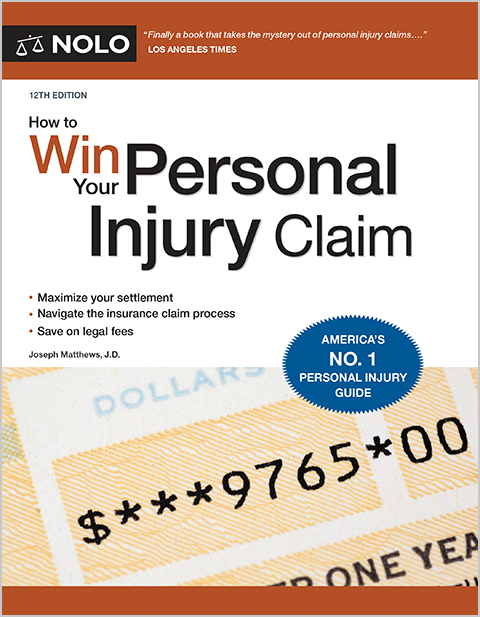Don't be surprised if the insurance company or the person you're suing uses these arguments to try limiting (or even barring) your personal injury claim.
If you're thinking about making a personal injury claim after any kind of accident, you'll need to understand what kinds of arguments and defense strategies you can anticipate from the other side. Should you be on the other side, with someone is claiming that you're at fault for causing their injuries, you'll want to understand some defense strategies that can help you avoid injury liability.
In this article, we'll focus on legal defenses and arguments that an injured person might face in response to an injury-related insurance claim or personal injury lawsuit, including a few that relate to the plaintiff's potential fault for the underlying accident, and the concept of "assumption of the risk."
- Was the Injured Person Also at Fault for the Accident?
- When Does "Assumption of Risk" Apply to a Personal Injury Case?
- Personal Injury Defenses Related to "Causation"
- The "Preexisting Injury" Argument In a Personal Injury Case
- The Statute of Limitations Defense to a Personal Injury Case
- Next Steps In an Injury Claim
Was the Injured Person Also at Fault for the Accident?
When someone files an injury-related insurance claim or personal injury lawsuit, one of the first arguments usually heard from the other side is that the injured person was at fault for the accident (in whole or in part).
If there's evidence that your own negligence played a part in the accident that caused your injuries, the compensation you receive will probably be affected. Timing-wise:
- this could happen early on, if the insurance adjuster can show that you bear some amount of blame for your accident, and you're trying to settle your personal injury case out of court, or
- it could happen in court (though it's very rare for personal injury cases to make it all the way to trial), after the judge or jury reaches a finding on liability (fault for the accident) and figures out how much compensation ("damages") you should receive.
The degree to which an injury settlement or court award could be affected by your share of fault—or the chance that your recovery will be barred altogether—depends on whether your state follows a "comparative negligence" or "contributory negligence" rule.
What Is Comparative Negligence In a Personal Injury Case?
Most states follow a "comparative negligence" rule in personal injury cases, calculating damages under a formula that looks at each party's degree of fault for the accident.
Say you're in a car accident and the jury finds you were 25% at fault, while the other driver is found 75% to blame. In this situation, the court will reduce your total damages by 25%—your share of fault for the accident. For example, suppose your total damages add up to $20,000. You'll receive 75% of that amount, or $15,000.
The Difference Between "Pure" and "Modified" Comparative Negligence
Most states follow the comparative negligence rule in personal injury cases. But these states also fall into one of two camps:
- those that use a "pure comparative negligence" rule, and
- those that go with "modified comparative negligence."
What's the difference between the two? In a "pure" comparative negligence state, an injured plaintiff can recover damages regardless of their share of fault. For instance, a plaintiff who's 99% to blame can still recover 1% of their damages from other at-fault parties. In a "modified" comparative negligence system, an injured plaintiff can recover compensation only if they are no more than 50% at fault (or less than 50% at fault in some states).
What Is Contributory Negligence In a Personal Injury Case?
While comparative negligence can reduce an injured person's compensation when they're partly at fault, the concept of contributory negligence isn't as forgiving. In these five contributory negligence states, claimants who share any degree of fault for their own accident or injury are usually barred from getting any compensation in court:
- Alabama
- District of Columbia
- Maryland
- North Carolina, and
- Virginia.
Let's suppose you live in one of these contributory negligence states and you're in a car accident that was 1% your fault. You can't recover any compensation for your damages through a personal injury lawsuit.
The same will be true even if you're only making a car insurance claim but haven't filed a lawsuit. Expect the insurance company's settlement offer to be very low if it looks like you share any car accident fault. After all, insurance companies settle claims with an eye toward what's likely to happen if a case makes it to court.
There's No Fault Formula
There's no formula for assigning a percentage to your fault—or that of the other person. During claim negotiations, you'll come up with a percentage for each at-fault party. The insurance adjuster will almost certainly arrive at different percentages, and will try to explain why you bear greater responsibility for the accident. To decide how much your claim is worth, you and the insurance company will negotiate over percentages of fault and many other factors.
When Does "Assumption of Risk" Apply to a Personal Injury Case?
In some personal injury cases, a defendant faced with a lawsuit will argue that the injured person "assumed the risk" of getting injured by willfully participating in an activity that the injured person knew (or should have known) was dangerous. This kind of defense is raised most often in lawsuits that stem from contact sports (like football and basketball) and spectator injuries (when a foul ball hits a spectator in the stands at a baseball game, for example).
The "Assumed" Risk Must Relate to the Activity
One key aspect of a successful "assumption of the risk" defense is that the harm suffered must relate closely to the risk that's inherent in the activity. So if you're playing a game of organized basketball at the local gym, you've probably assumed the risk of getting elbowed inadvertently—since that's a common occurrence in a game of basketball. A lawsuit over any resulting injuries probably wouldn't fly, because you assumed the risk of injury by deciding to play in the game.
On the other hand, if you got injured playing basketball when the backboard broke and fell on you, the defendant (the gym owner, for example) couldn't rightly argue that you assumed the risk of such a thing happening, because a falling backboard isn't a danger that's inherent in the game of basketball.
Personal Injury Defenses Related to "Causation"
An insurance company or lawsuit defendant might also argue that, while it's clear that the claimant was injured, some other event, circumstance, or conduct was the actual cause of the injury. This kind of legal argument can get complex, but it boils down to this: A successful personal injury case requires proof that:
- the person you're trying to hold responsible for your injuries was negligent, and
- that negligence was the cause of your injuries.
If something else entirely—either occurring before or after the defendant's negligent act—may have been the actual cause of your injuries, the defendant might have a valid "causation" defense.
Learn more about causation and "intervening" and "superseding" causes.
The "Preexisting Injury" Argument In a Personal Injury Case
Another argument that an injured person is likely to hear is that they have a preexisting condition (an injury or illness) that partially or completely explains the medical issues they're currently claiming. This is another variation of the causation argument discussed above. You'll want an experienced personal injury lawyer to navigate this issue should it come up in your case.
Learn more about how a preexisting condition can affect a personal injury case.
The Statute of Limitations Defense to a Personal Injury Case
In every state, a law called a "statute of limitations" sets a strict time limit on the right to file a lawsuit. Different deadlines apply to different kinds of cases. If you miss the filing deadline set by law for your case, you'll almost certainly lose the right to file your lawsuit.
In the context of a personal injury case, missing the statute of limitations deadline means you'll no longer have the chance to ask a court for a legal remedy for the harm you've suffered. In other words, the person you're trying to sue will be off the legal hook.
Learn more about the statute of limitations in a personal injury case.
Next Steps In an Injury Claim
If you're making an injury claim and the other side has raised any of the defenses we've discussed here, things can get complicated pretty quickly. It might make sense to discuss your situation with an experienced legal professional. Here's how to find a lawyer who's right for your case.
- Was the Injured Person Also at Fault for the Accident?
- When Does "Assumption of Risk" Apply to a Personal Injury Case?
- Personal Injury Defenses Related to "Causation"
- The "Preexisting Injury" Argument In a Personal Injury Case
- The Statute of Limitations Defense to a Personal Injury Case
- Next Steps In an Injury Claim


